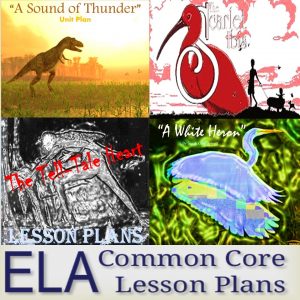After teaching students about characterization and point of view, I felt pretty good about myself, so good in fact, that I commissioned the pottery teacher to create an action sculpture of me in the center of my classroom.
But after grading the 93rd imagery analysis paragraph that stated “the author uses imagery to paint a picture in the reader’s mind,” I destroyed the half-finished sculpture and demanded my money back. I had failed. My students knew nothing about imagery in literature or its purpose.
The pottery teacher refused to give back my money, but she did give me a short stories for teaching imagery lesson plans bundle and a swift kick in the behind.
Short Stories for Teaching Imagery in Literature

- “The Scarlet Ibis” by James Hurst. The story opens with “It was in the clove of seasons, summer was dead but autumn had not yet been born, that the ibis lit in the bleeding tree.” Hurst uses personification–“summer was dead”–an ominous beginning. The image of a bleeding tree, the clove–a red flower–and the ibis–which we know to be scarlet–are connotative of blood and death. The remainder of the opening paragraph contains the following images: rotting brown magnolia petals, rank iron weeds, an empty cradle, graveyard flowers whose smell drifted through every room of the narrator’s house. It doesn’t take Shakespeare to figure out this story will be about death.
- “A Sound of Thunder” by Ray Bradbury. This Bradbury classic is best known for creating the Butterfly Effect concept. It’s a suspense-filled travel through time that involves hunting dinosaurs and altering the future. Bradbury’s genius can be found in his description of time-travel and his incredible depiction of a Tyrannosaurus Rex.
- “A White Heron” by Sarah Orne Jewett. A hunter offers Sylvia $10 if she can help him find a white heron. Silvia dreams of the many things she could buy with $10. Sylvia also takes a liking to the charming hunter and seeks to gain favor in his sight. But when she spots the whereabouts of the highly-valued bird, she’s not sure whether or not she will divulge its location. This story has become a favorite of tree huggers and environmentalists, but to categorize this story so narrowly does it a disservice. Regardless of your environmental leanings, “A White Heron” is an American classic.
- “The Pit and the Pendulum” by Edgar Allan Poe. Poe is regarded as a master of suspense and America’s finest horror writer. What often goes unnoticed is his amazing power of description. I can’t help but feel rats scurrying across my face every time I read it.
There were even some poems by Emily Dickinson in the unit, so I could brag about my ability to integrate poetry into my short story units.
Looks like it’s time to get started on that statue again!
Share This: